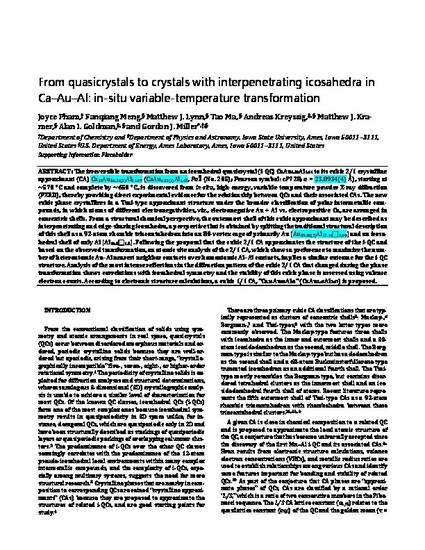
The irreversible transformation from an icosahedral quasicrystal (i-QC) CaAu4.39Al1.61 to its cubic 2/1 crystalline approximant (CA) Ca13Au56.31(3)Al21.69 (CaAu4.33(1)Al1.67, Pa3̅ (No. 205); Pearson symbol: cP728; a = 23.8934(4)), starting at ∼570 °C and complete by ∼650 °C, is discovered from in situ, high-energy, variable-temperature powder X-ray diffraction (PXRD), thereby providing direct experimental evidence for the relationship between QCs and their associated CAs. The new cubic phase crystallizes in a Tsai-type approximant structure under the broader classification of polar intermetallic compounds, in which atoms of different electronegativities, viz., electronegative Au + Al vs electropositive Ca, are arranged in concentric shells. From a structural chemical perspective, the outermost shell of this cubic approximant may be described as interpenetrating and edge-sharing icosahedra, a perspective that is obtained by splitting the traditional structural description of this shell as a 92-atom rhombic triacontahedron into an 80-vertex cage of primarily Au [Au59.86(2)Al17.14□3.00] and an icosahedral shell of only Al [Al10.5□1.5]. Following the proposal that the cubic 2/1 CA approximates the structure of the i-QC and on the basis of the observed transformation, an atomic site analysis of the 2/1 CA, which shows a preference to maximize the number of heteroatomic Au–Al nearest neighbor contacts over homoatomic Al–Al contacts, implies a similar outcome for the i-QC structure. Analysis of the most intense reflections in the diffraction pattern of the cubic 2/1 CA that changed during the phase transformation shows correlations with icosahedral symmetry, and the stability of this cubic phase is assessed using valence electron counts. According to electronic structure calculations, a cubic 1/1 CA, “Ca24Au88Al64” (CaAu3.67Al2.67) is proposed.
Available at: http://works.bepress.com/gordon-miller/136/
